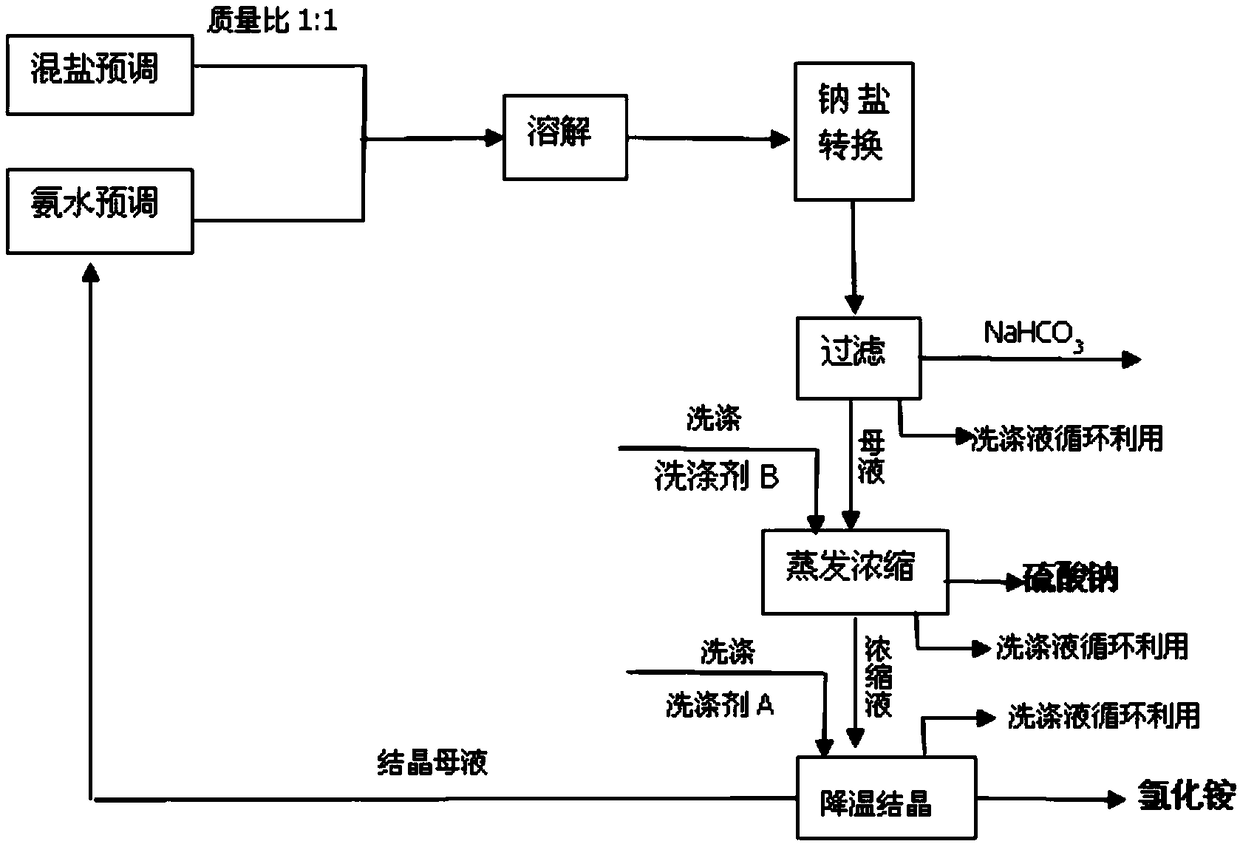Separating and using method for mixed sodium salt
A technology of sodium salt and mixture, which is applied in the field of separation and utilization of mixed sodium salt, can solve the problems of small application market and low resource value of industrial grade sodium chloride and sodium sulfate products, and achieve strong reproducibility, short process route, The effect of low operational difficulty
- Summary
- Abstract
- Description
- Claims
- Application Information
AI Technical Summary
Problems solved by technology
Method used
Image
Examples
Embodiment 1
[0066] 1) Pre-preparation of mixed sodium salt: Weigh 50.16g of thermoelectric mixed salt and 9.84g of agrochemical salt, of which sodium chloride accounts for 37.92% in thermoelectric salt, sodium sulfate accounts for 54.36%, and sodium chloride in agrochemical salt accounts for The proportion is 89.53%, and sodium sulfate accounts for 3.17%. According to the mass ratio of 1:1, it is configured as a mixed sodium salt system 60g, simulating the mixed sodium salt produced in industrial production;
[0067] 2) Sodium salt inorganic conversion: use 300g of dilute ammonia water with a concentration of 10% to dissolve the mixed salt, pass in carbon dioxide through the gas-liquid two-phase reaction for 20 hours, and obtain sodium bicarbonate, ammonium chloride, and sulfuric acid through the conversion of the sodium salt system Sodium mixed system, the ammonium ion concentration is 6.39%, the chloride ion concentration is 5.16%, the sodium ion concentration is 2.65%, and the sulfate ...
Embodiment 2
[0072] 1) Pre-preparation of mixed sodium salt: Weigh 76g of analytically pure sodium sulfate and sodium chloride, and configure 152g of mixed sodium salt system according to the mass ratio of 1:1, simulating the mixed sodium salt produced in industrial production;
[0073] 2) Inorganic conversion of sodium salt: Dissolve the mixed salt with 800g of dilute ammonia water with a concentration of 10% ammonia water, and pass in carbon dioxide to conduct a gas-liquid two-phase reaction for 20 hours, and obtain sodium bicarbonate, ammonium chloride, and sulfuric acid through the conversion of the sodium salt system Sodium mixed system, the ammonium ion concentration is 5.01%, the chloride ion concentration is 6.52%, the sodium ion concentration is 2.59%, and the sulfate ion concentration is 7.29%.
[0074] 3) Concentration and precipitating: 670g of sodium sulfate and ammonium chloride mixed system was evaporated and concentrated at -0.095Mpa, 80°C, the amount of steamed water was 43...
PUM
 Login to View More
Login to View More Abstract
Description
Claims
Application Information
 Login to View More
Login to View More - R&D
- Intellectual Property
- Life Sciences
- Materials
- Tech Scout
- Unparalleled Data Quality
- Higher Quality Content
- 60% Fewer Hallucinations
Browse by: Latest US Patents, China's latest patents, Technical Efficacy Thesaurus, Application Domain, Technology Topic, Popular Technical Reports.
© 2025 PatSnap. All rights reserved.Legal|Privacy policy|Modern Slavery Act Transparency Statement|Sitemap|About US| Contact US: help@patsnap.com

